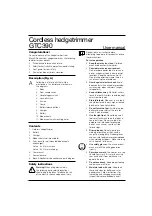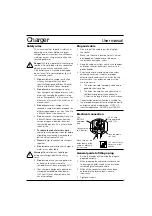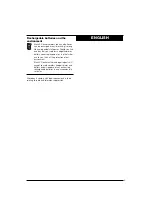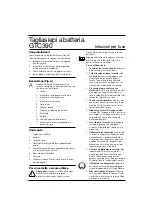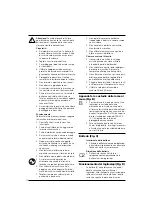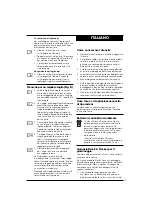
7
Safety rules
This manual contains important safety and
operating instructions. Before using your
charger, read all instructions and cautionary
markings on your charger, your battery and
your hedgetrimmer.
!
Danger!
240 volts are present at the charging
terminals. Do not probe with any conductive
objects or you will risk an electric shock.
If the battery case is cracked or damaged,
do not insert it into your charger or you will
risk an electric shock.
•
Do not
attempt to charge your battery
with any charger other than those
specifically designed by Black & Decker
for use with Black & Decker batteries.
•
Do not
expose your charger to water.
Your charger is not intended for any uses
other than charging the products listed
under “Energy packs” in this manual. Any
other uses may result in the risk of fire or
electric shock.
•
Do not
operate your charger if it has
received a sharp blow, been dropped, or
otherwise damaged in any way. Take it to
a Black & Decker service centre.
•
Do not
take your charger apart; take it to
a Black & Decker service centre when
service or repair is required. Incorrect
reassembly may result in a risk of electric
shock or fire.
•
To reduce the risk of electric shock,
unplug your charger from the outlet before
attempting any cleaning. Removing your
battery will not reduce this risk.
•
Never
attempt to connect two chargers
together.
•
Do not
freeze or immerse your charger in
water or any other liquid.
!
Warning!
Do not allow any liquid to get
inside your charger; electric shock may
result.
•
Do not
store or use your hedgetrimmer
or battery in locations where the
temperature may reach or exceed 40˚C.
•
Your charger is designed to operate on
standard household electrical power
(240 volts). Do not attempt to use it on
any other voltage!
Plug and cable
•
Do not tug at the cable to pull the plug from
the socket.
•
Make sure the cord is located so that it will not
be stepped on, tripped over, or otherwise
subjected to damage or stress.
•
Keep the cable away from heat, oil, sharp edges
and rough surfaces and always ensure it is in
good condition.
•
An extension cord should not be used unless
absolutely necessary. Use of an improper
extension cord could result in a risk of fire and
electric shock. If an extension cord must be
used, make sure:
•
The extension cord is properly wired and in
good electrical condition.
•
The extension cord has a conductor cross
sectional area greater than or equal to
0.5mm
2
and a length of less than 30 metres.
•
The extension cord classification is suitable for
the intended environment as specified; domestic
and light commercial application - HO5V V-F,
industrial application - HO5RR-F or HO5RN-F.
Electrical connection
Fit a
BS1363A
approved
plug
Connect blue
to N (neutral)
Make sure that the
outer sheath of the
cable is held firmly
by the clamp
Fit a 3 amp
fuse approved
to BS1362
Connect brown
to L (live)
240 volts AC only.
Never use a light
socket
General guide to fitting a plug
•
Ensure the lengths of wire inside the plug are
prepared correctly.
•
When preparing the cable ends take care not
to damage the outer sheath or the insulation
surrounding the inner conductors.
•
When all the conductor strands have been
entered into the terminal posts, secure
them firmly.
•
Tighten all screws.
Charger
User manual




